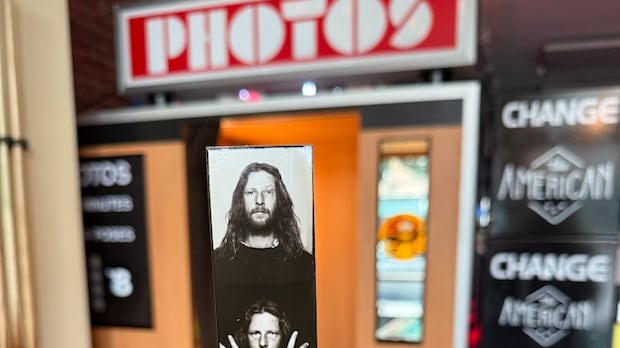LISTEN | Full interview with photo booth mechanic Rafael Hortala-Vallve:As It Happens6:28It’s been 100 years since the invention of the photo boothFor Rafael Hortala-Vallve, there’s nothing quite like the feeling of stepping into a photo booth, closing the little curtain, seeing those rapid-fire flashes, then leaving with a warm, freshly printed strip of perfectly imperfect portraits.“Even though I’m a photographer, there is the beauty of this photographer-less photography,” Hortala-Vallve told As It Happens guest host Dave Seglins.Hortala-Vallve is the founder of Autofoto, a organization of self-taught technicians and mechanics dedicated to preserving and restoring Europe’s last remaining photo booths.This year marks the 100th anniversary of the invention of the photo booth, and Autofoto is collaborating with the Photographers’ Gallery in London on a new exhibit, Strike a Pose! 100 Years of the Photobooth.Open through February, the exhibit is a nostalgic journey through history, featuring one of Autofoto’s vintage machines from the ‘60s, and photo booth strips from the last 10 decades. But the century-old technology is making a resurgence in the selfie-era, striking a particular chord with young people who grew up with smartphones in their pockets.A Times Square debutEarly patents and prototypes for automatic photography machines date back to the late 1880s.But the photo booth as we now know it — an enclosed space with an automatic flash that generates a strip of printed photographs for a few bucks — was the brainchild of Anatol Marco Josepho, a Russian-Jewish immigrant to New York City.He unveiled his first machine — called the Photomaton — in 1925 in Times Square, and patented it for $1 million US two years later.Anatol Josepho in his Photomaton, which he patented in 1927. (Raynal Pellicer/Photographers’ Gallery)After that, the technology took off, and was soon found in airports, malls, arcades, museums and sidewalks around the world. A favourite of tourists and passersby, they were also popular among celebrities, including musician and artist couple John Lennon and Yoko Ono, former U.S. president and first lady John and Jacqueline Kennedy, and pop artist Andy Warhol, who used a photo booth for his famous series of self-portraits.’Digital was the future. Analog was old-school’Hortala-Valve began his love affair with the technology in 2009, when he tried to acquire one for his friend’s wedding. “I reached out to the companies here in the U.K., in Spain, in Italy, and they didn’t have any. They had thrown them all in the [trash] because digital was the future. Analog was old-school,” he said.Some of the images on display at the Photographer’s Gallery in London, England, to celebrate the 100th anniversary of the invention of the photo booth. (Raynal Pellicer/The Photographers’ Gallery )Eventually, he lucked out with a seller in Montreal. And once he had one, he was determined to keep it functional.“That was just a side passion of mine to keep one of these photo booths alive for myself for as long as possible,” he said. “I learned the hard way by trial and error.”Since then, he’s founded Autofoto, which restores and repairs analog photo booths in London and Barcelona, upgrading their parts as they go with more durable materials, like stainless steel, to keep them alive longer. ‘A labour of love’Refurbishing those old machines is no easy feat. You have to be part-carpenter, part-mechanic and part-chemist.“It is absolutely a labour of love,” said Ian Azariah, founder of Phototronic, a photo booth company in British Columbia. Phototronic refurbishes and maintains photo booths, and builds custom ones, too. The company operates 14 of them in B.C., six of which are analog. Ian Azariah is the founder of Phototronic, which refurbishes, builds and operates photo booths in British Columbia. (Submitted by Ian Azariah)You can tell if a photo booth is analog, Azariah says, because it will take four minutes to print the pictures. If they spit out immediately, it’s a digital machine. While he’s got a passion for the vintage ones, he says both versions offer a kind of magic.“In the world where we live now, where everything is on our phones, it’s so special to have physical memories anywhere you can get them,” Azariah said.Back from the brink When Azariah first got into the world of analog photo booths in 2016, he says their numbers were dwindling. He couldn’t find any that still worked in Vancouver.“I felt it was special and it should be preserved,” he said. “I was like, well, yeah, why not? I’ll do it.”The culture, he says, has changed a lot since then. Photo booths are making a comeback, especially among young adults. “People are rediscovering [them], or discovering them for the time,” he said. “Gen Z is very tuned into things that are quite authentic and real in the sense that they understand when something is sort of mass produced and when something isn’t unique.”The feeling you get stepping into an analog photo booth for the first time, he says, is akin to what music lovers experiences the first time they hear a vinyl record. “I think when these people experience true analog photo booths, they’re just really kind of mesmerized.”Two women check photos they took in a selfie photo booth shop, a modern take on the photo booth, in Busan, South Korea. (Anthony Wallace/AFP/ Getty Images)Hortala-Vallve has noticed a similar phenomenon in Europe. And, according to the New York Times, people in their 20s can be seen lining up at vintage photo booths across New York City, operated by the company Classic Photo Booth.“I love the tangible memories that are created, and that you only have four shots,” Melissa Veerasammy, 28, told the Guardian last month at the International Photobooth Convention in New York City.It makes perfect sense to Hortala-Vallve.“Young generations might be a bit saturated with the amount of images they have out there, with the control they have creating their own images, trying to reach the perfection, the exact image they have in their minds,” he said.The beauty of a photo booth, he says, lies in its constraints. It’s a perfect memory, frozen in time as a keepsake you can put on your fridge or use as a bookmark. “There’s no retakes. There’s no perfecting that particular pose,” he said. “I think there is a coming back to this more human, maybe more tangible, aspect of the past.”
The photo booth turns 100 this year. Why it’s making a comeback in the selfie era












